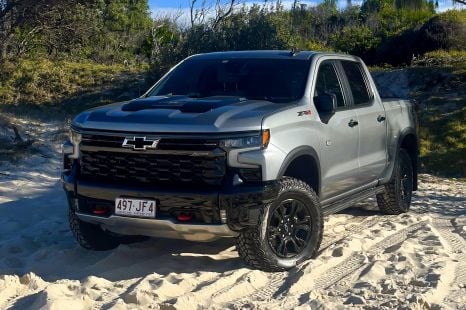

William Stopford
2025 Chevrolet Silverado ZR2 review
1 Month Ago
VW has launched a range of new accessories for its Amarok dual-cab, including canopies, camping gear and lift kits. Are they any good?
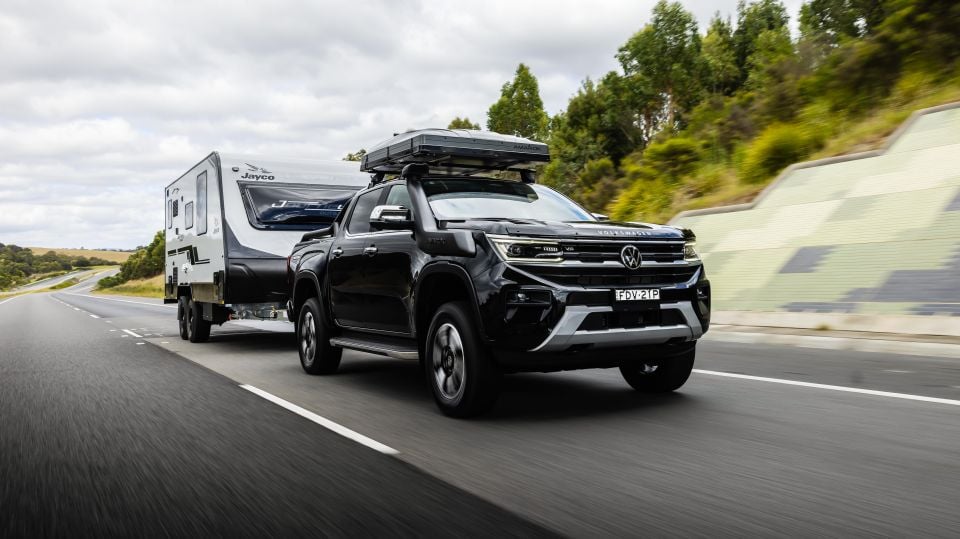
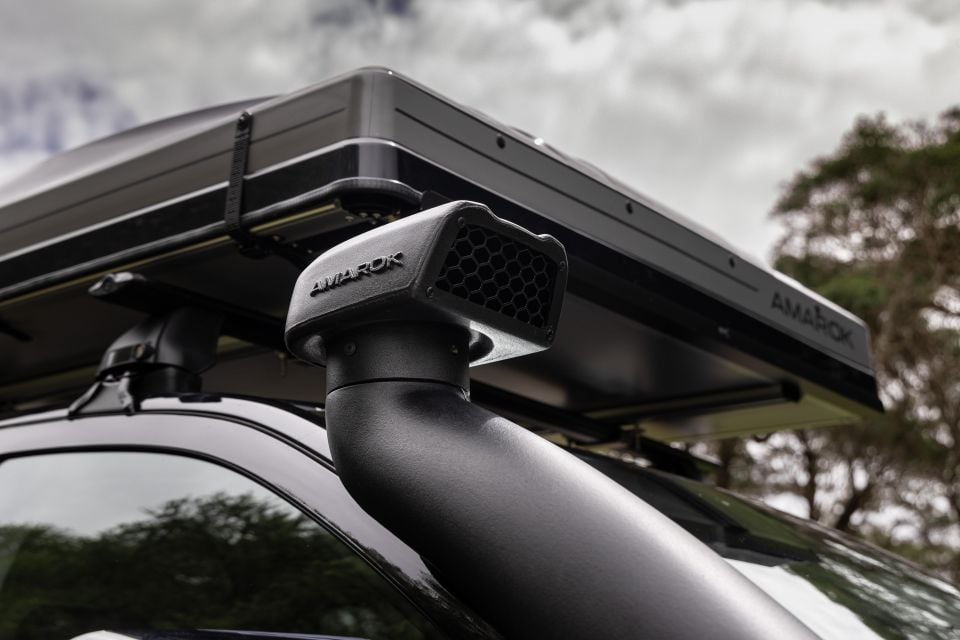

Quickly see how this car stacks up against its competition. Select any benchmark to see more details.
Where expert car reviews meet expert car buying – CarExpert gives you trusted advice, personalised service and real savings on your next new car.
Aussies love a dual-cab ute, and Aussies also love doing dual-cab utes up with tailored accessories and add-ons to suit their lifestyle needs.

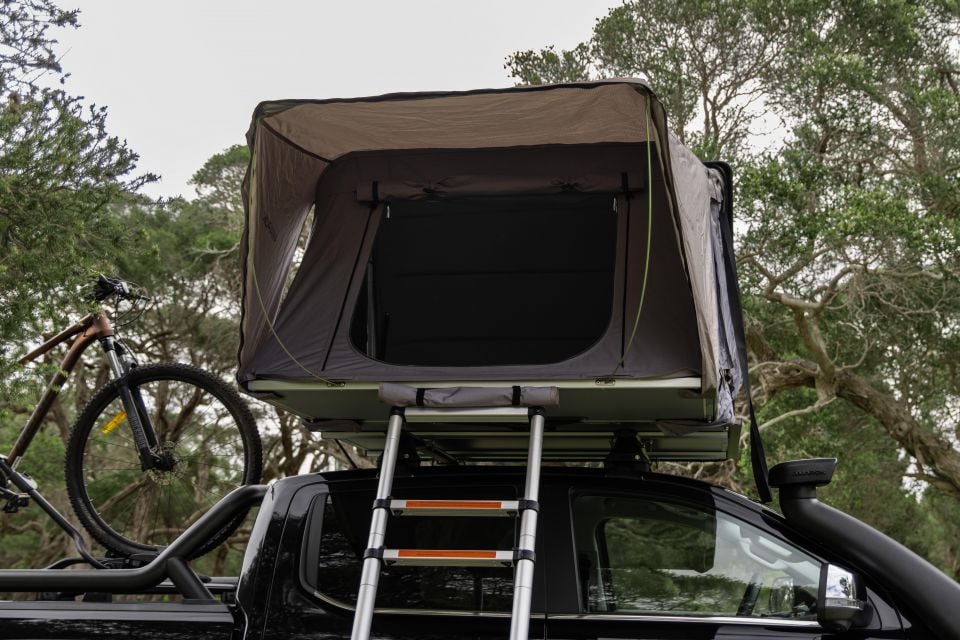
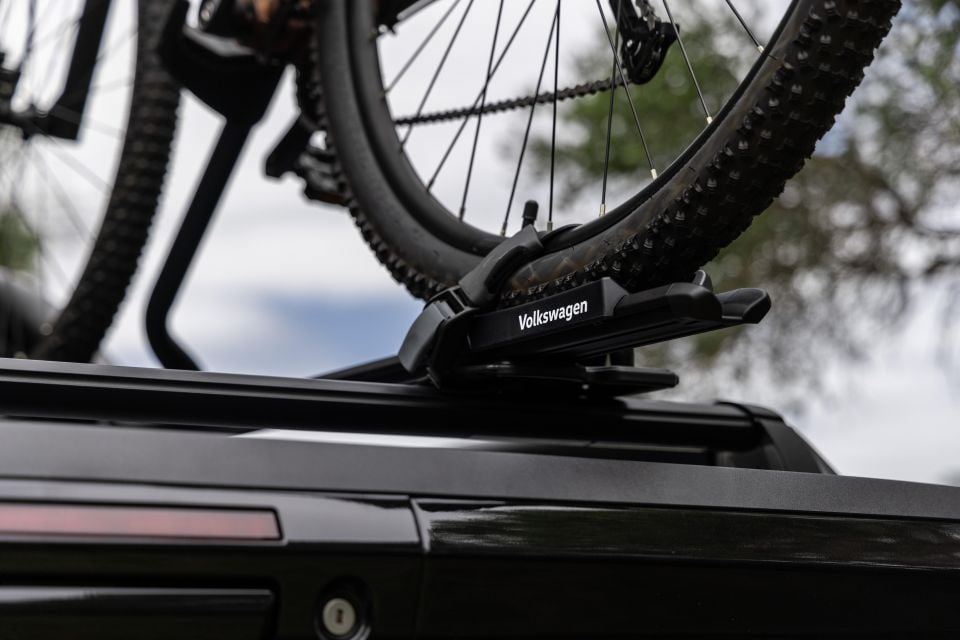
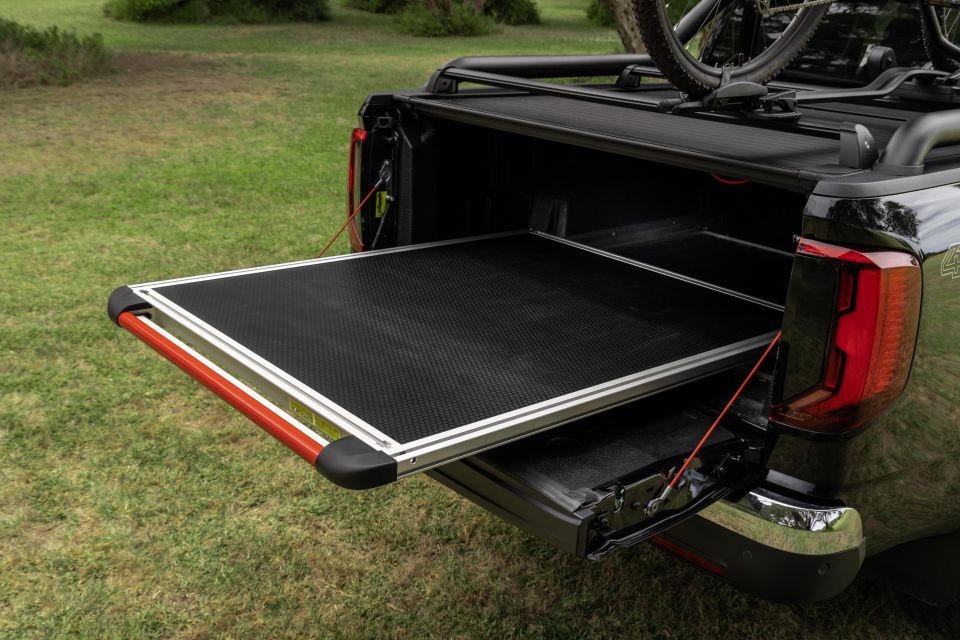
It has meant a goldmine for the aftermarket, but in recent years most manufacturers have been releasing more and more genuine and warranty-backed accessories to keep customers within brand showrooms.
In many cases, manufacturers have established strong partnerships with third-party suppliers that would normally service the aftermarket.
The 2024 Volkswagen Amarok is pretty fresh in market, having gone on sale last year based on the capable underpinnings of the latest Ford Ranger. Like its Ford-branded relative, we think it’s a segment benchmark.
While not quite the runaway success on the sales charts as the top-ranked Ford, the second-gen Amarok has been setting sales records in Australia, achieving an all-time monthly sales record of 1011 in October last year, and an average of 854 Australian monthly sales since it launched in May.
In 2024, VW Commercial Vehicles Australia says its on track to meet its 10,200-unit Amarok forecast for the year, which would be almost double its 2023 result and much more competitive with the likes of the Mitsubishi Triton and Mazda BT-50 for annual volume.
But VW Commercial Vehicles Australia wasn’t content with ‘just’ having a Ranger alternative in showrooms, and it’s now gone and developed a range of accessories including canopies, camping gear, lift kits and more.
All can be bought from and fitted by the brand’s national dealer network spanning over 100 locations, and all are backed by a five-year, unlimited-kilometre warranty.
We joined a media showcase of a variety of the new Amarok accessories range in Victoria, to see whether it’s worth shopping in-house for your Amarok add-ons.
Note: As this review mainly revolves around the accessories range, we’ve focused on related areas like pricing and drive impressions. Notably, interior and powertrain sections have been left out.
Volkswagen Commercial Vehicles Australia has introduced a number of MY24 drive-away deals for the Amarok.

2024 Volkswagen Amarok drive-away offers:
| Model Variant | Drive-away price |
|---|---|
| 2024 Volkswagen Amarok Core TDI405 | $57,490 |
| 2024 Volkswagen Amarok Life TDI500 | $61,490 |
| 2024 Volkswagen Amarok Style TDI500 | $71,740 |
| 2024 Volkswagen Amarok Style TDI600 | $75,740 |
Each drive-away offer includes a complimentary five-year Care Plan, which is valued at $1900 for MY24 (+$100).
The wider range has seen price rises against recommended retail pricing (RRP) but these have been offset somewhat by added equipment. All models get an electronic brake controller as standard (normally $1180 fitted) and a tow ball ($33), while the base Core picks up blind-spot monitoring and rear cross-traffic alert.
Otherwise, trim offerings and general specifications remain unchanged.
2024 Volkswagen Amarok pricing:
| Model Variant | $RRP |
|---|---|
| 2024 Volkswagen Amarok Core TDI405 | $55,490 (+$2500) |
| 2024 Volkswagen Amarok Life TDI500 | $59,490 (+$2500) |
| 2024 Volkswagen Amarok Style TDI500 | $69,740 (+$2750) |
| 2024 Volkswagen Amarok Style TDI600 | $73,740 (+$2750) |
| 2024 Volkswagen Amarok PanAmericana TDI600 | $78,990 (+$3000) |
| 2024 Volkswagen Amarok Aventura TSI452 | $82,990 (+$3000) |
| 2024 Volkswagen Amarok Aventura TDI600 | $82,990 (+$3000) |
All prices exclude on-road costs
As for the accessories, we won’t bore you with the full three-page table of the whole range plus pricing, but we’ll detail the headline ones below with their respective prices as fitted.
For more information on the Amarok accessories range, visit the brand’s website.
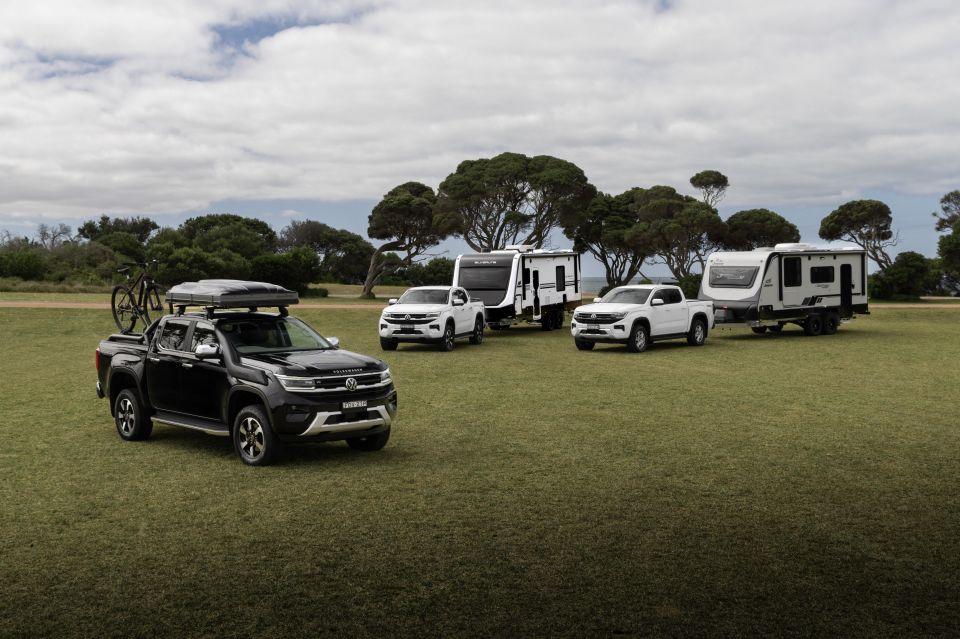
Accessories pricing:
Off-Road Expedition range
| Description | RRP Fitted (incl. GST) |
|---|---|
| Amarok front 40mm lift kit – Heavy Suspension To suit Amarok V6 / with bullbar | $1600 |
| Amarok front 40mm lift kit | $1505 |
| Amarok rear 40mm lift kit – 300kg constant loading | $2510 |
| Amarok rear 40mm lift kit | $2315 |
| Full underbody vehicle protection | $1655 |
| Wheel arch flares – matte black | $1640 |
| Nudge bar – silver or black Includes integrated LED light bar | $1600 |
| Snorkel To suit Amarok V6 | $1120 |
| Recovery boards – grey | $365 |
| Amarok Snatch Kit – recovery bag set | $225 |
Canopy range
| Description | RRP Fitted (incl. GST) |
|---|---|
| High-spec canopy with sliding windows left, right and wing lock | $5825 |
| High-spec canopy with sliding window | $5650 |
| High-spec canopy with swinging window | $6185 |
| Roof rack with overhang – mounting on canopy | $730 |
| J-brace canopy mounting | $490 |
Roof transport
| Description | RRP Fitted (incl. GST) |
|---|---|
| Roof bars with overhang To suit factory roof rails | $465 |
| Roof bars without overhang To suit factory roof rails | $605 |
| Roof bas with overhang To suit without factory roof rails | $600 |
| Platform mount Requires roof bars | $1440 |
| Roof top tent – 2 person, Amarok branding Requires roof bars | $3345 |
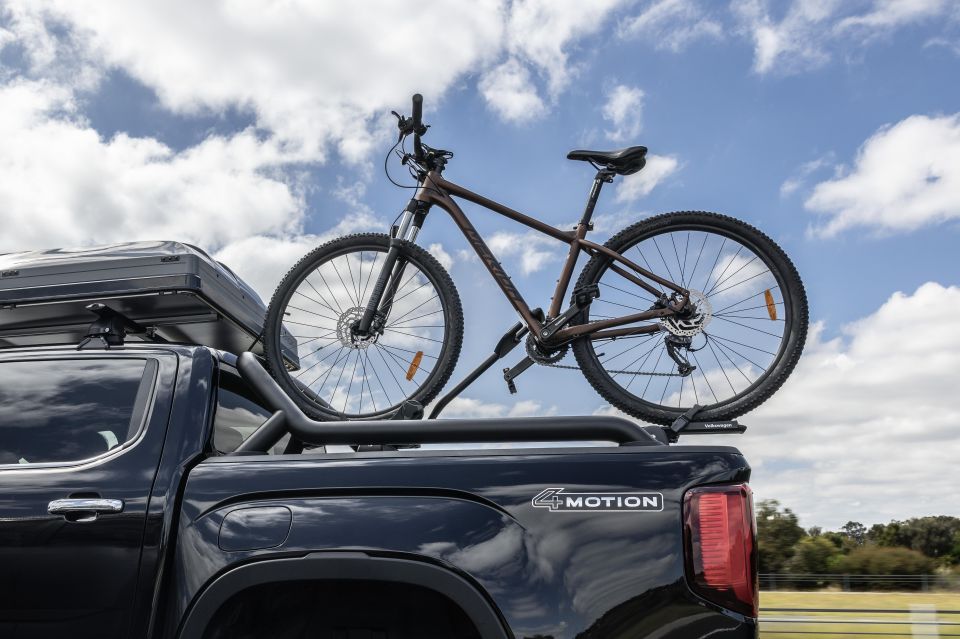
Rollcover range
| Description | RRP Fitted (incl. GST) |
|---|---|
| Electric roll cover – black Not for Amarok Aventura | $4690 |
| Manual roll cover – aluminium or black | $4255 |
| Soft tonneau cover To suit vehicles with load rest | $1895 |
| Soft tonneau cover To suit vehicles with styling bar | $1305 |
| Soft tonneau cover To suit vehicles without styling bar | $1305 |
| Modular bedliner To suit Core, Life, Style | $910 |
Styling bar
| Description | RRP Fitted (incl. GST) |
|---|---|
| Styling bar long – stainless steel or matte black To suit Core, Life, Style | $2975 |
Electrical accessories
| Description | RRP Fitted (incl. GST) |
|---|---|
| Auxiliary battery kit – under bonnet In development | $TBC |
| Auxiliary battery kit – tub mounted In development | $TBC |
| Accessory switch bank kit | $1070 |
Buy your new car without the stress. It's fast, simple and completely free.

Great service from Travis and team, second time I have used this business would not hesitate to recommend them to anyone
Craig C.
Purchased a Ford Ranger in Sunshine Coast, QLD
CarExpert helped Craig save $7,224 on his Ford Ranger, now let us save you on your next new car.
Get your BEST priceWe had three distinct drive programs for different accessories and packs, so I’ll signpost them as such.
Towing
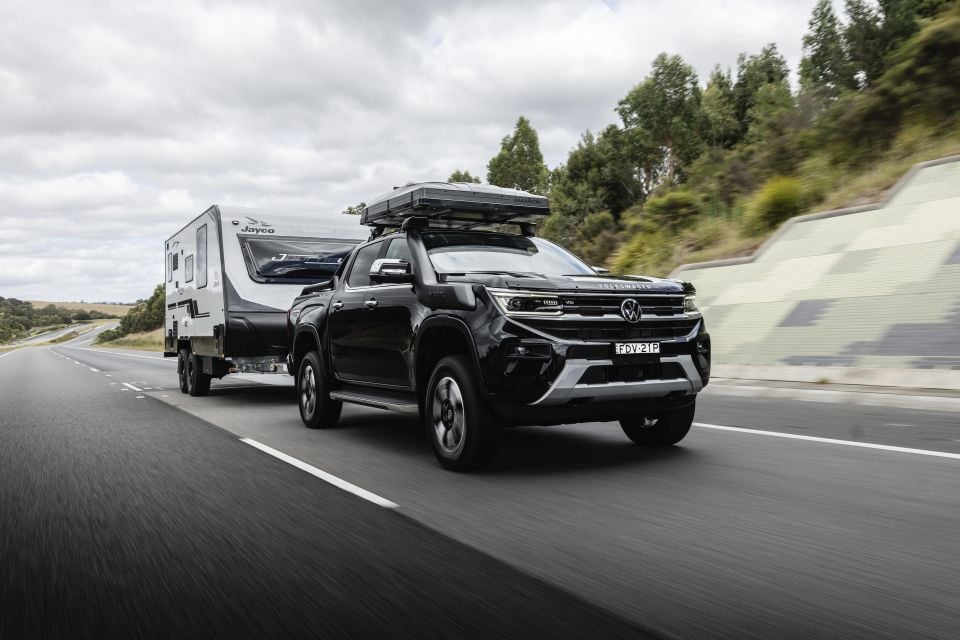
Our first leg was a back-to-back tow test in both TDI600 and TDI500 versions of the Amarok, with enormous Jayco Silverline caravans hitched to the rear – weighing between 2930kg and 3100kg as towed.
I rode shotgun in an Amarok Style TDI600 to begin with, with the heavier 3.1t Outback variant of the Jayco Silverline in tow. For the record, both caravans on test were about 9.0m long and 2.6m wide.
Ben Triebels, product manager for the Amarok at Volkswagen Commercial Vehicles Australia, was pilot for this leg and gave me a crash course (not literally) in towing larger caravans, and also gave me tutorials for all the various systems.
For example, the Amarok’s Tow/Haul Mode has various helpful features to get you all set up before you hit the road.
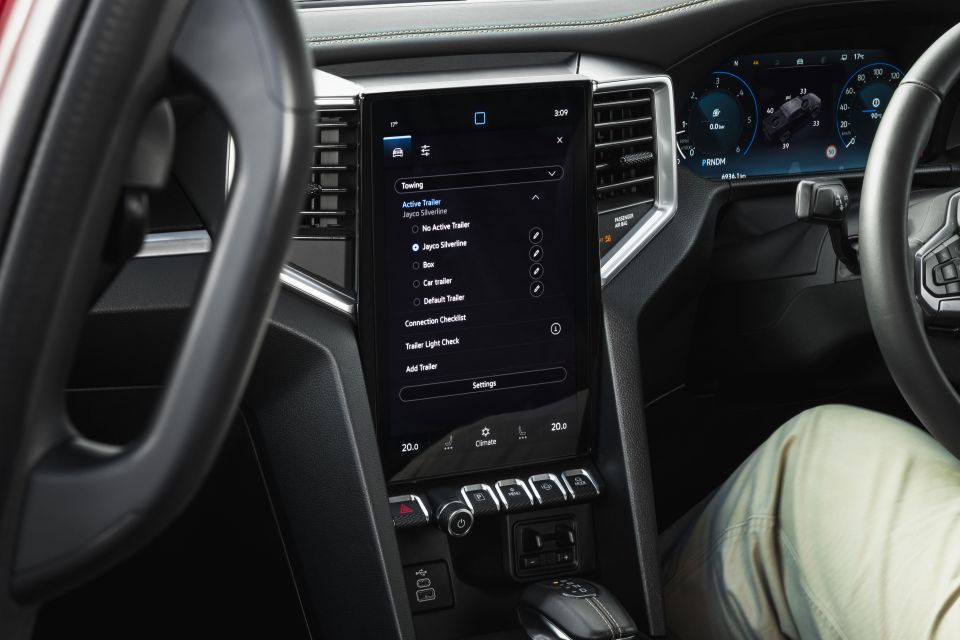
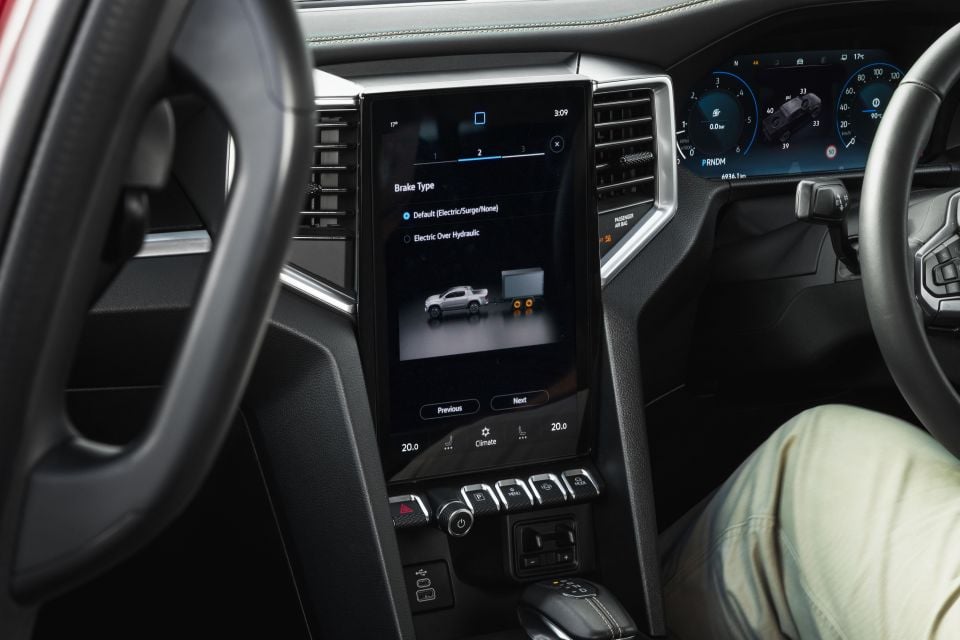
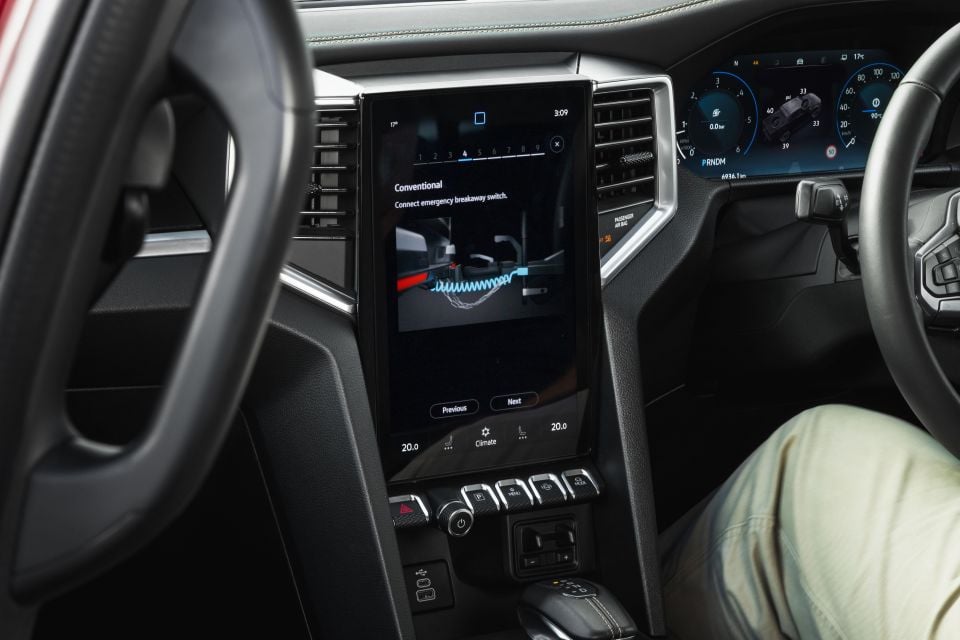
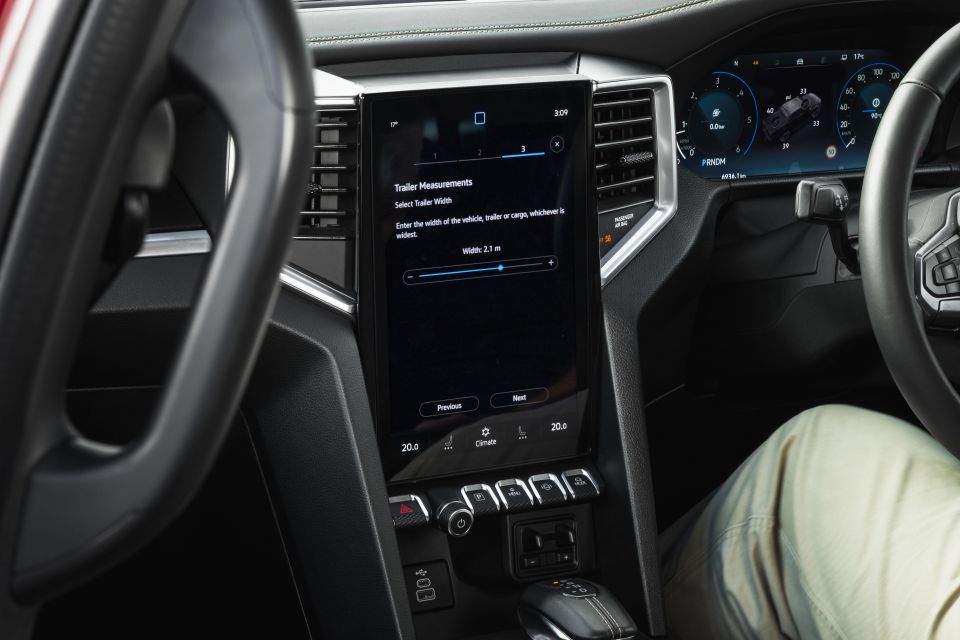
Once the mode is selected, you can input the dimensions of your trailer and the vehicle’s systems will tailor themselves accordingly.
Blind-spot monitoring will adapt its reach to account for the length of the trailer, and rear cross-traffic alert will be deactivated when a trailer is hitched.
The trip computer will also monitor fuel efficiency data for the Amarok when hooked up to that specific trailer, and will show a corresponding driving range. You can save up to 10 different trailers in the infotainment system, and as you select each one all the related data will be shown so you have the most accurate information at hand.
Like the Ford Ranger, you can also conduct a light test that will run a sequence of checks for each light five times, so that you don’t need to have someone standing out the back yelling out if each light does or doesn’t work.
There’s also a nine-step trailer connection checklist so you don’t miss anything.
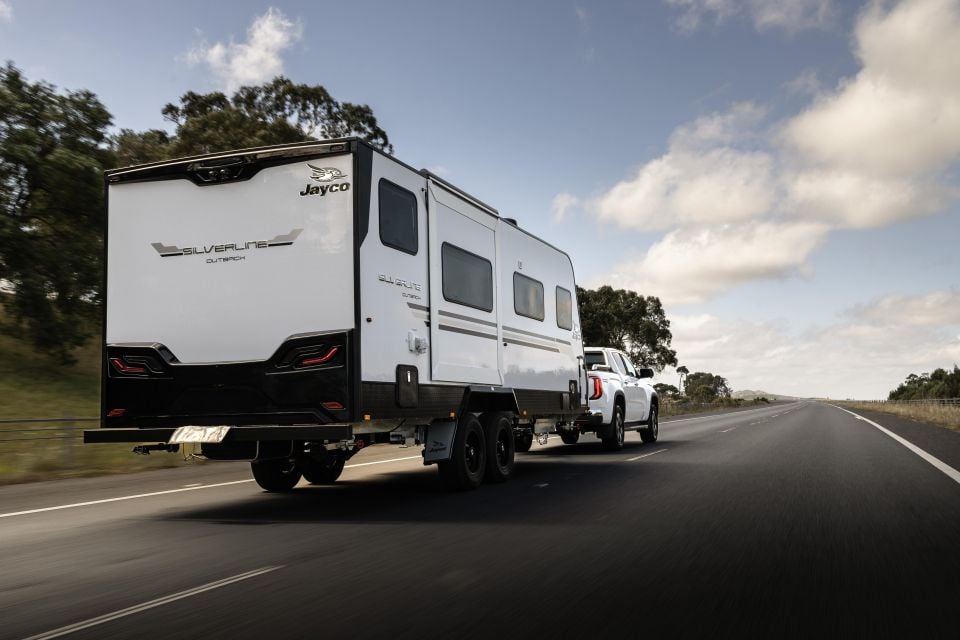
Anyway, with the 3.1t caravan on the back the V6-powered Amarok pulled strongly and smoothly, with the selected Tow/Haul model optimising gearshifts for better performance. The V6 Amarok will also automatically engage its 4A driveline setting in this mode.
What this means is that the Amarok will hold gears for longer to ensure the engine performance is best suited to towing conditions, rather than chasing efficiency with earlier shift points. It’ll also engine brake in all forward gears, and adjusts said engine braking by brake pedal input.
With Mr Triebels at the wheel it was all smooth sailing, and it was quite impressive how the Amarok TDI600 remained settled and relatively refined with such a big load at the back. The test vehicle was also fitted with the 40mm lift kit accessory, for reference.
At times there was a little bit of bounce in the ride at higher speeds over bridge joins and harsher road undulations and imperfections, but at no point did it seem like the VW was hitting its limits.
After a quick pit stop and driver change, it was my turn.
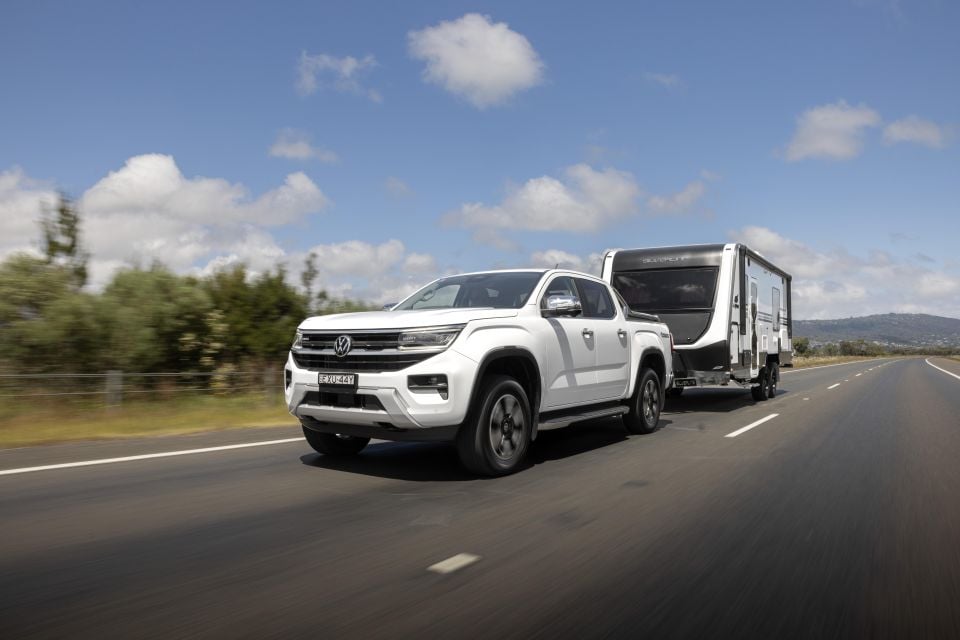
Full disclosure: I’m not a regular tower, and the 2.9t Jayco Silverline Tourer caravan hooked up to the Amarok Life TDI500 I drove is easily the largest tow load I’ve ever experienced. That said, I found it all surprisingly easy.
While the 2.0-litre BiTurbo diesel lacks the outright punch of the V6 (154kW/500Nm v 184kW/600Nm) as well as the more sophisticated four-wheel drive system with 4A mode which can engage on sealed surfaces, the four-pot Amarok did an admirable job of hauling such a big rig without really feeling underdone.
Sure it had to work that little bit harder than the V6, but the Amarok TDI500 still managed to offer good response and was more than capable of getting to highway speeds with adequate pace, and felt very planted and secure even on twistier sections of road.
My leg in the driver’s seat was mostly spent navigating the winding back roads headed into Gembrook, passing through Yarra Glen, which included plenty of hills, bumpy and skinny B-roads, as well as T-intersections and roundabouts that require that extra bit of thought when towing such a big load.
Braking was made a little easier thanks to the integrated electronic brake controller, which unlike some aftermarket systems monitors wheel speed and brake input data to gradually apply throttle much like the vehicle’s brakes, rather than just activating the trailer brakes when the brake lights are on.
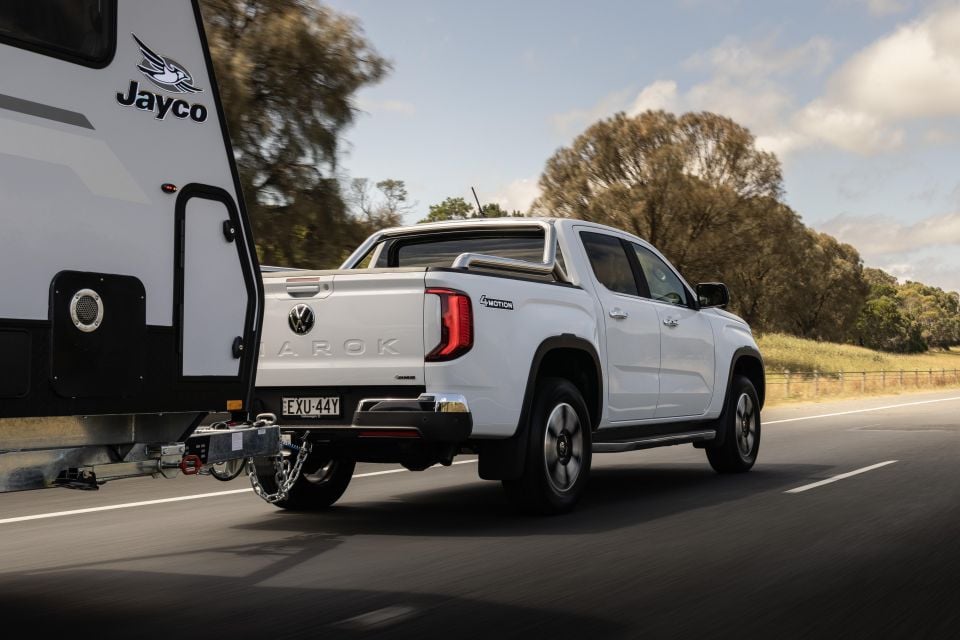
The gain can be set on a scale of 1-9, and there are preset Low, Medium and High settings when setting up a trailer profile in the Tow/Haul mode for added convenience. For our two big ol’ caravans, the gain was set to High.
Numerous times I had to slow fairly quickly from 80-100km/h approaching a roundabout or intersection and I was impressed with how linear and accurate brake response was. Not once did I lock them up.
The standard mirrors provided good visibility of the trailer’s sides so I was able to place the caravan nicely and keep it between the road markings without too much effort.
Volkswagen is also developing proper towing mirror accessories to add an even wider range of visibility while also properly integrating with blind-spot and surround-view camera systems.
Another fun fact is the one-touch indicators will automatically switch to five flashes instead of three when Tow/Haul mode is engaged. All of these things helped to inspire confidence, and take some of the complexity out of towing.
Lift kit on-road
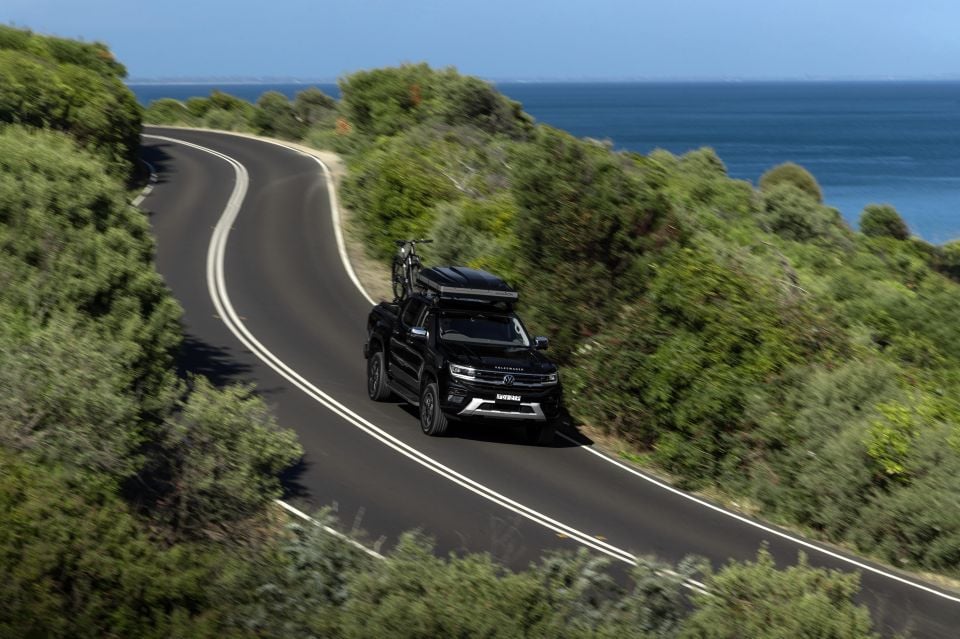
Our second test was a back-to-back drive of two Amarok Style models – one fitted with the 40mm lift kit accessory and the other with the standard suspension setup. VW sources the packages from Aussie supplier Old Man Emu, part of ARB.
I’ll flag first up that the lift kit-equipped Amarok was a TDI600 V6, while the standard running gear was fitted to a TDI500 BiTurbo. Either way, it was less about engine performance and more about the ride and handling here.
Now 40mm is quite a substantial lift, and it’s not like the standard Amarok is a low-riding vehicle. With the accessory suspension system fitted, the Amarok rides 275mm high, as opposed to the standard 235mm.
If that has you thinking that the lift kit will have the Amarok turn into a leaning, wallowing mess, you’d be wrong.
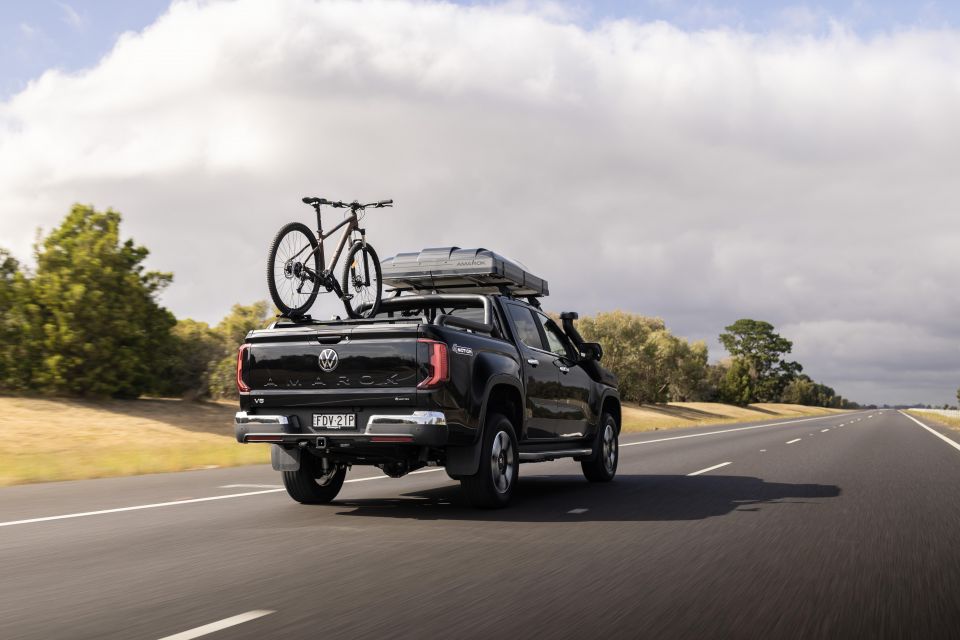
The standard Amarok was already one of the better-riding dual-cabs on the market, much like its Ford Ranger platform mate. With the lift kit added, the Amarok’s ride noticeably improves with no real compromise in handling ability or body control.
Hitting the B-roads surrounding Gembrook en route to Phillip Island via Pakenham in Victoria’s south east, the raised Amarok drives even more like an SUV than before.
Keeping in mind this is a commercial vehicle with rear leaf springs designed to still tow 3.5t and offer over 900kg of payload, the unladen Amarok Style TDI600 with lift kit strikes a great balance on road.
Bump absorption and isolation is excellent, while turn-in and roadholding remains strong for a vehicle of this type. It almost eliminates the rear jitters over sharper hits and settles better at higher speeds.
It also appears to reduce road noise inside thanks to the cabin being even further away from the ground.
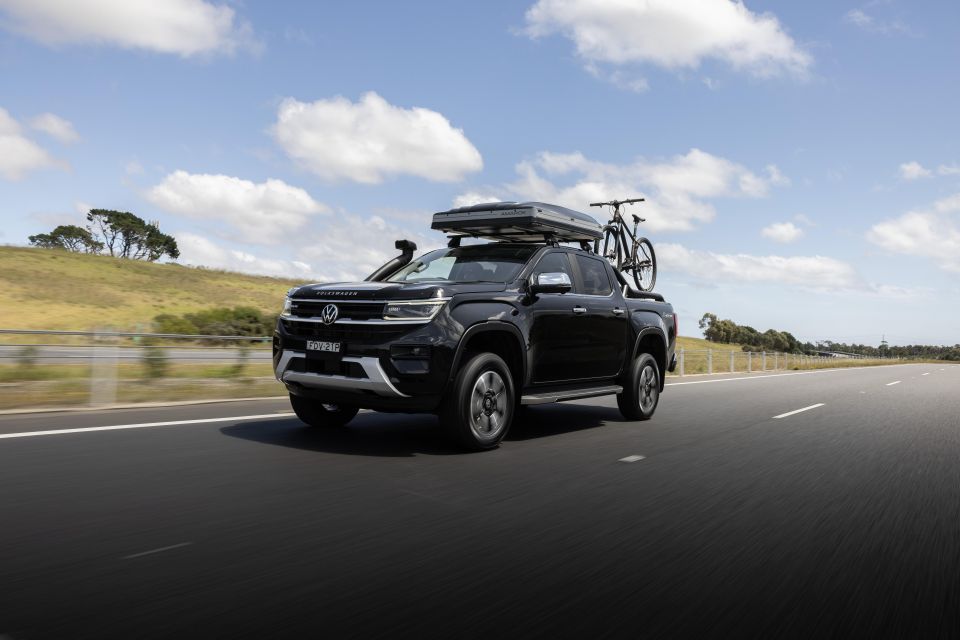
By comparison the standard setup in the BiTurbo was still good but felt noticeably firmer and was unsettled more easily by some of the nastier sections of blacktop on Victoria’s Bass Highway.
As is common in unladen dual-cab utilities, there’s an inherent firmness in the way the leaf-sprung rear suspension deals with sharper and higher frequency hits, though the Amarok is far from unrefined for the class.
The standard, lower ride height should also mean better aero which means less wind noise and improved fuel consumption – though a more scientific test with identical conditions would better determine the implications.
All told though, like the BT-50 with lift kit I sampled a couple of years back, the Amarok’s optional suspension upgrades make a positive difference on-road as well as off the beaten track – more on the latter next.
Lift kit off-road
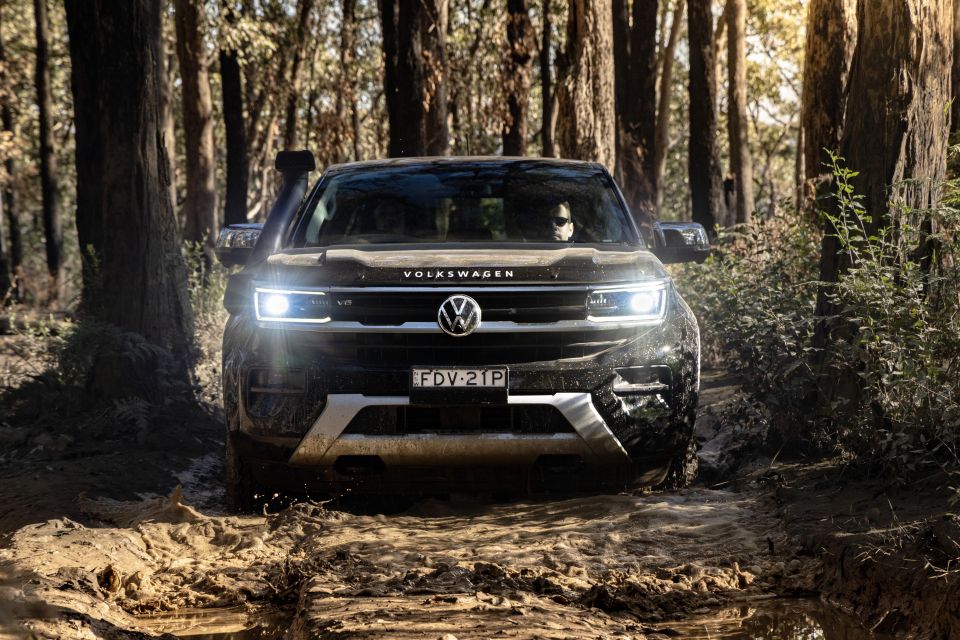
Where expert car reviews meet expert car buying – CarExpert gives you trusted advice, personalised service and real savings on your next new car.
Time to get down and dirty.
On day two of the drive program, after having a stint in the Crafter Kampervan by Jayco (review here), we got a stint in the Amarok with lift kit up some gnarly trails in the Toolangi Forest.
It was a short but pretty intense hillclimb with very deep ruts and rocky sections which would be a good test for ground clearance, articulation and traction. VW told us the standard Amarok wasn’t able to complete this exercise.
We hopped back into the Style TDI600 with the 40mm lift kit and slowly headed up the designated trail. After driving up the access road and seeing the steepness of the path ahead and the terrain, I got a little nervous.
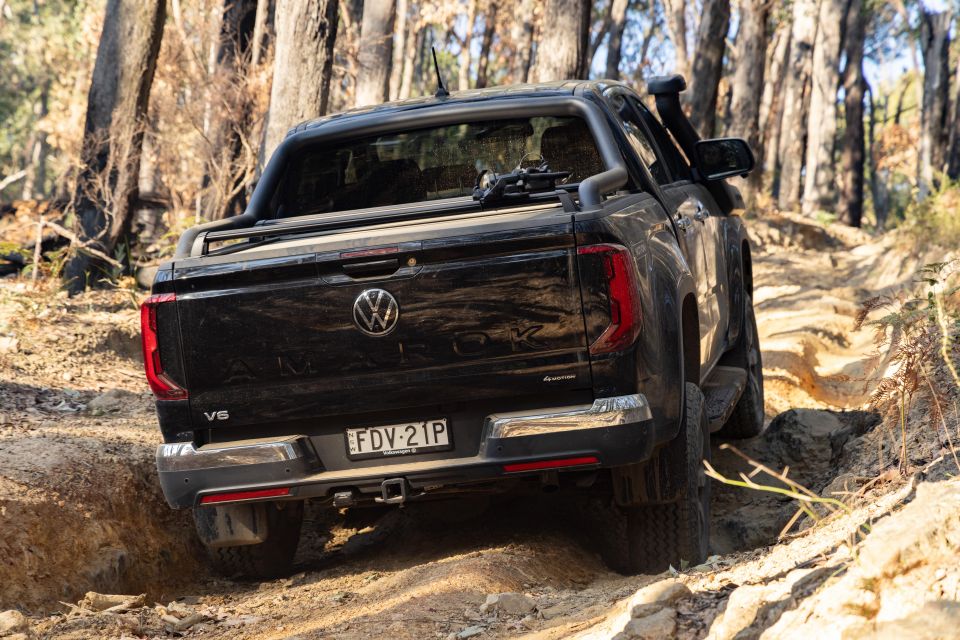
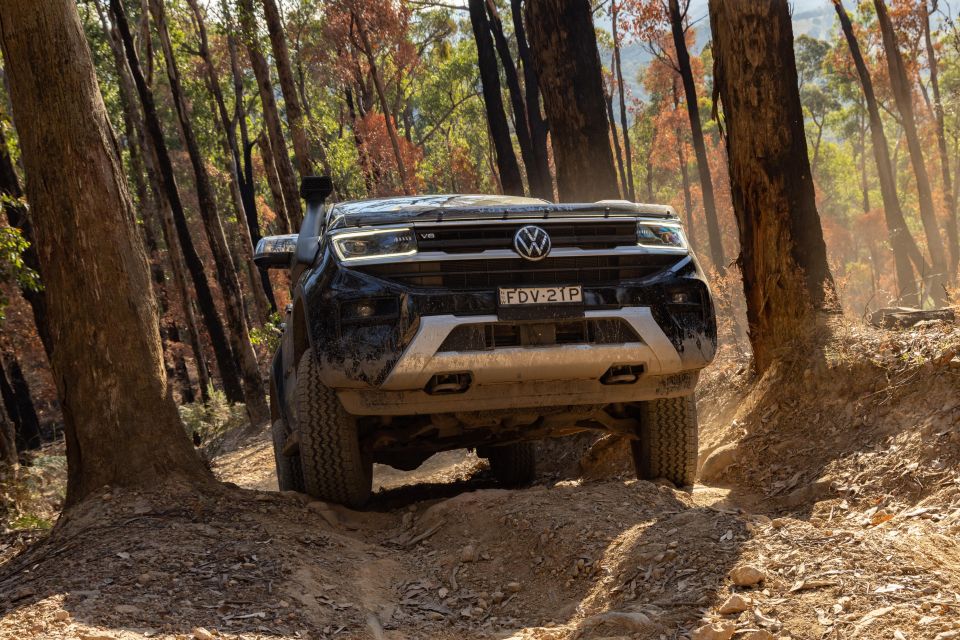
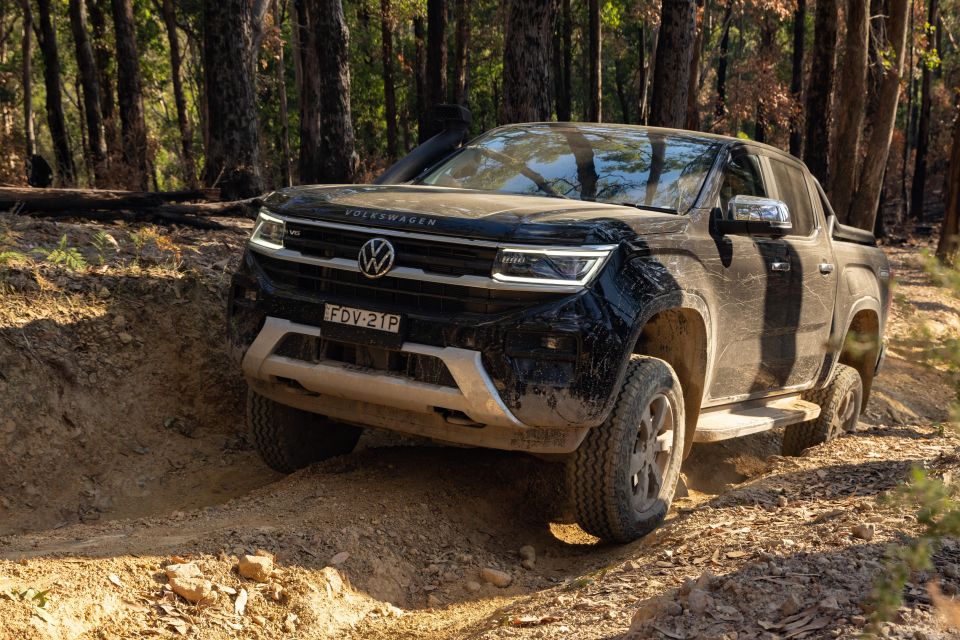
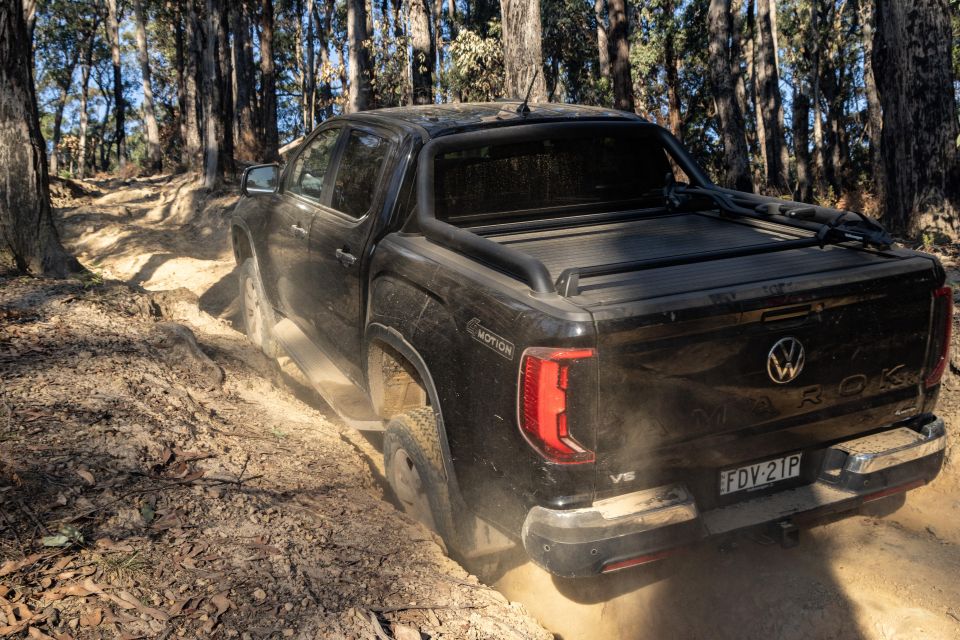
But I was told to push on, so I put on a brave face and forged ahead, even if I wasn’t so sure I’d make it up without dinging the underbody. We flicked the rear differential lock on, but I don’t recall putting it into its Slippery or Mud off-road modes.
Much to my surprise, the Amarok got up very cleanly and without much fuss. In addition to the 40mm lift, the suspension upgrade no doubt opens up better approach, departure and breakover angles, though VW doesn’t quote exact values – for reference, the standard car quotes 30/25.6/22 degrees respectively.
The Amarok was nicely responsive to the measured, light throttle inputs necessary for maintaining a constant but gradual climbing speed.
Even as the ruts got deeper and the climb got steeper, the Amarok soldiered on. The underbody protection may have been touched once, but otherwise it cleared the rutted and rocky climb with little fuss – even with running boards.
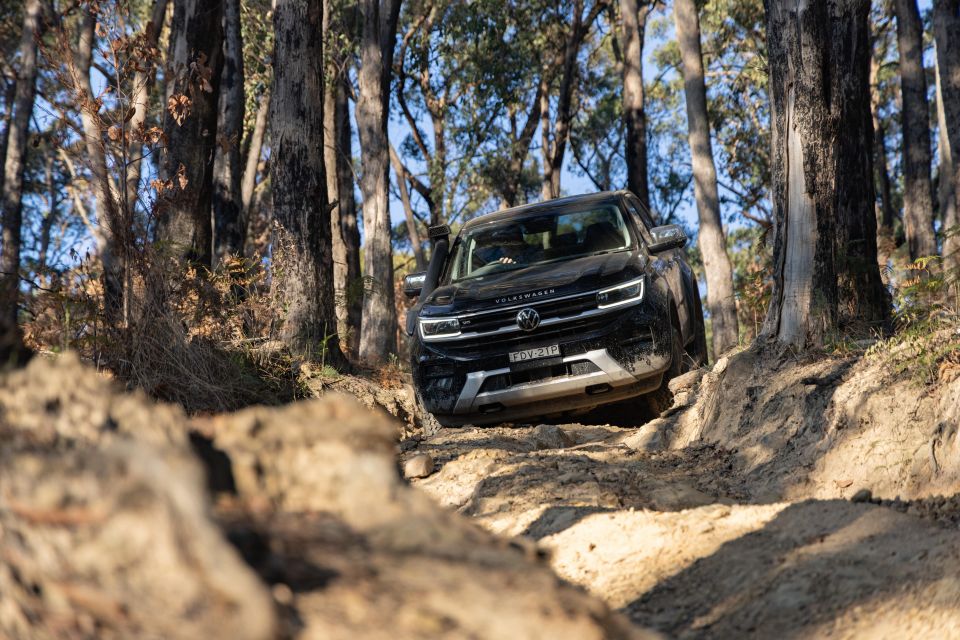
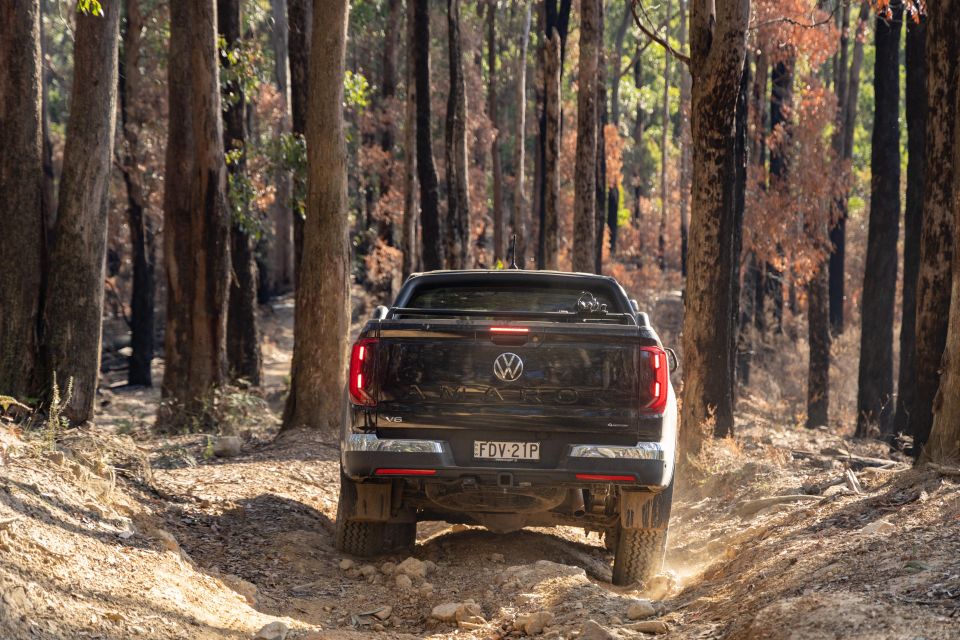
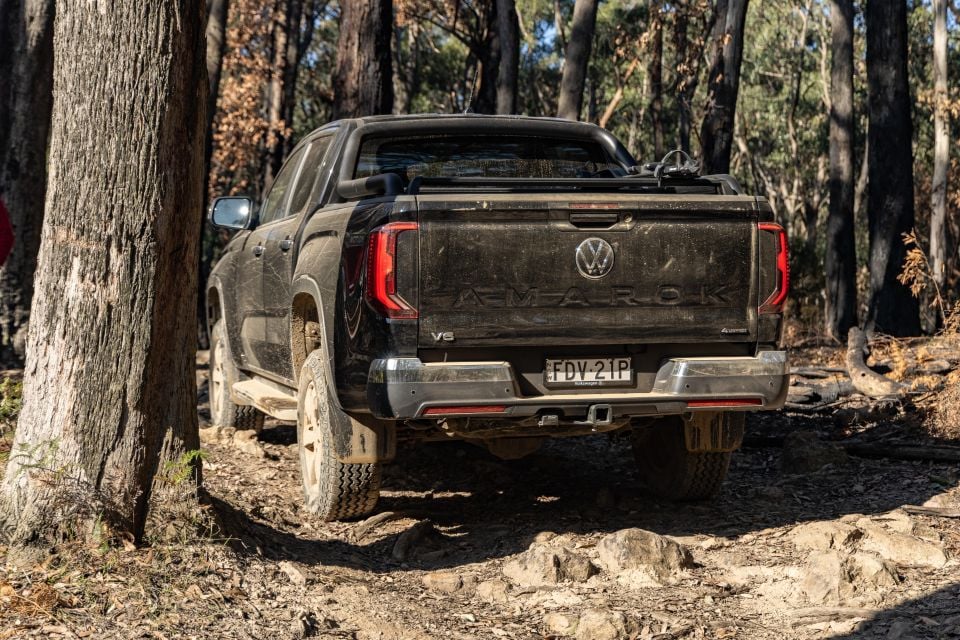
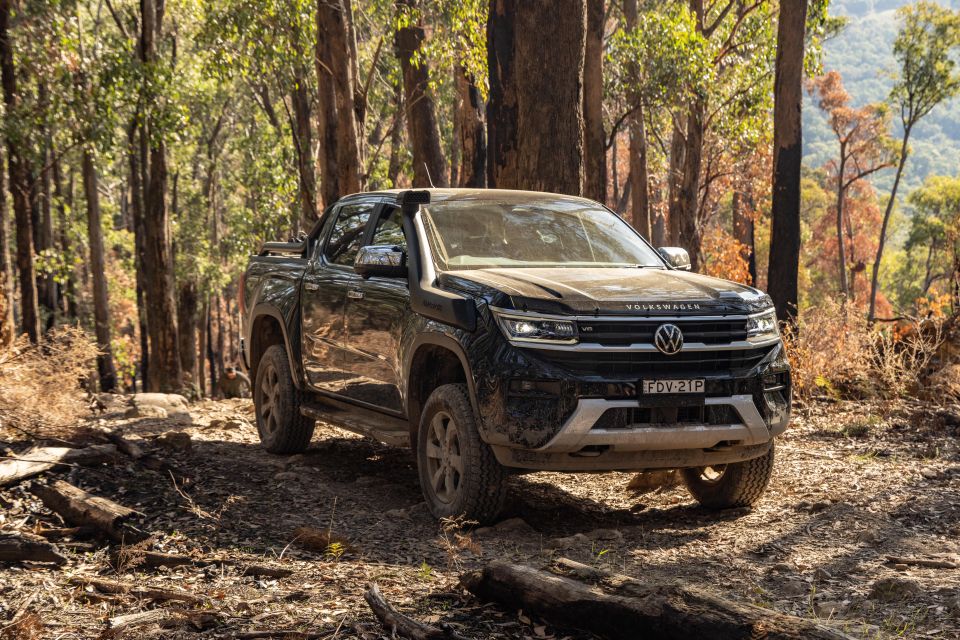
It’s worth noting the accessorised Style used here – which in addition to the snorkel, lift and bash plates had a number of fitted accessories that took it to $93,821 as tested – was also wearing a set of Goodyear Wrangler Territory all-terrain tyres (around $337 each) similar to the ones you get on the higher-spec PanAmericana.
If there was anything to complain about, for me it would be that the bonnet line is quite high and restricts view when coming over crests. This can be offset somewhat with the forward-facing camera, but it’s worth noting.
On the trail back down the hill we encountered some pretty big and sharp humps that would really test out the breakover angle. These artificial mounds did see the side steps graze slightly with four adult men on board, but apparently with two-up on earlier runs they hadn’t posed any issues.
Long story short, the Amarok was pretty impressive.
The Amarok lineup comprises five distinct trim levels.

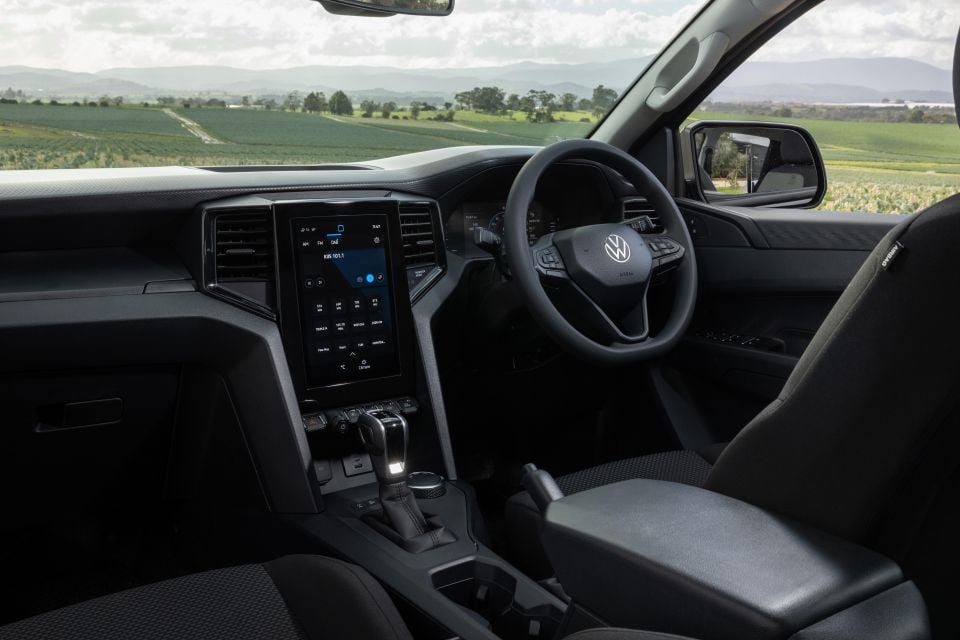
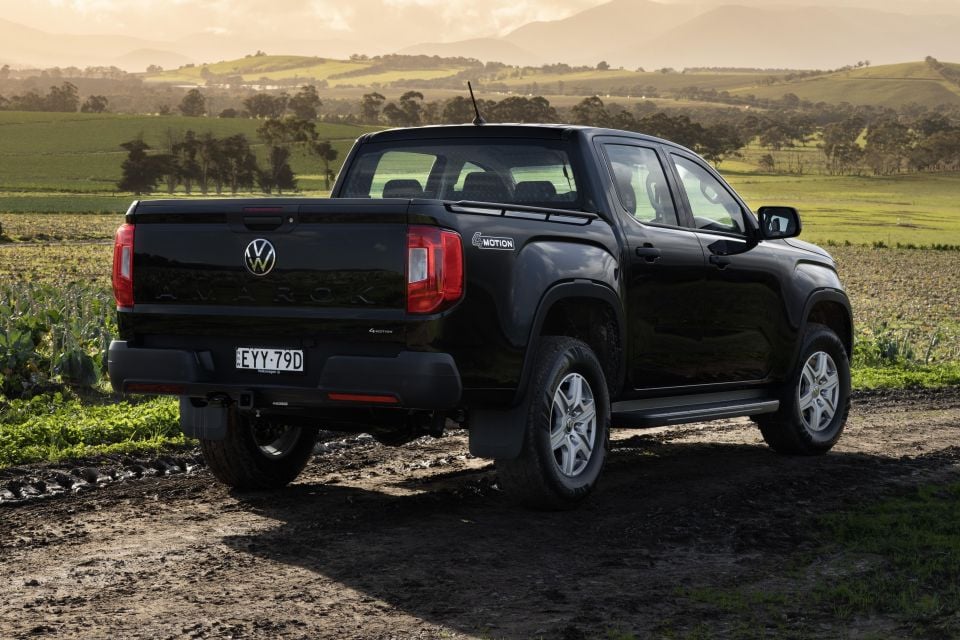
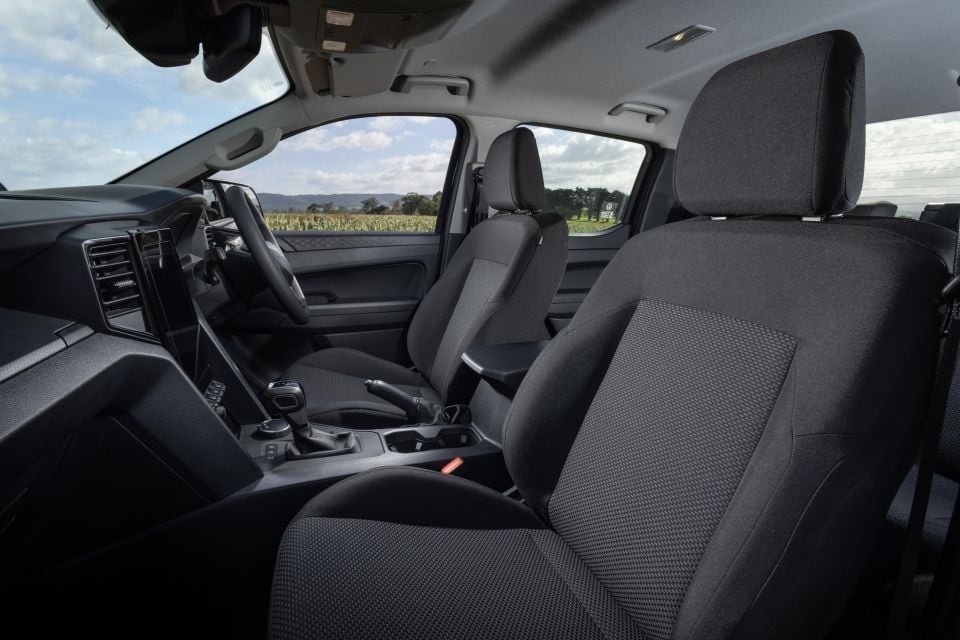
Amarok Core highlights:
Exterior
Interior
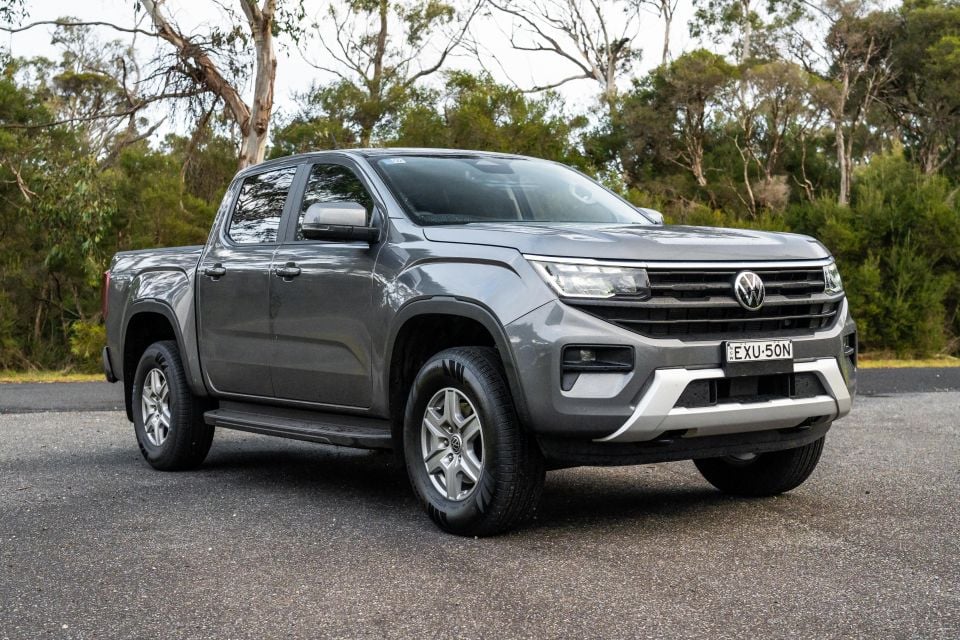
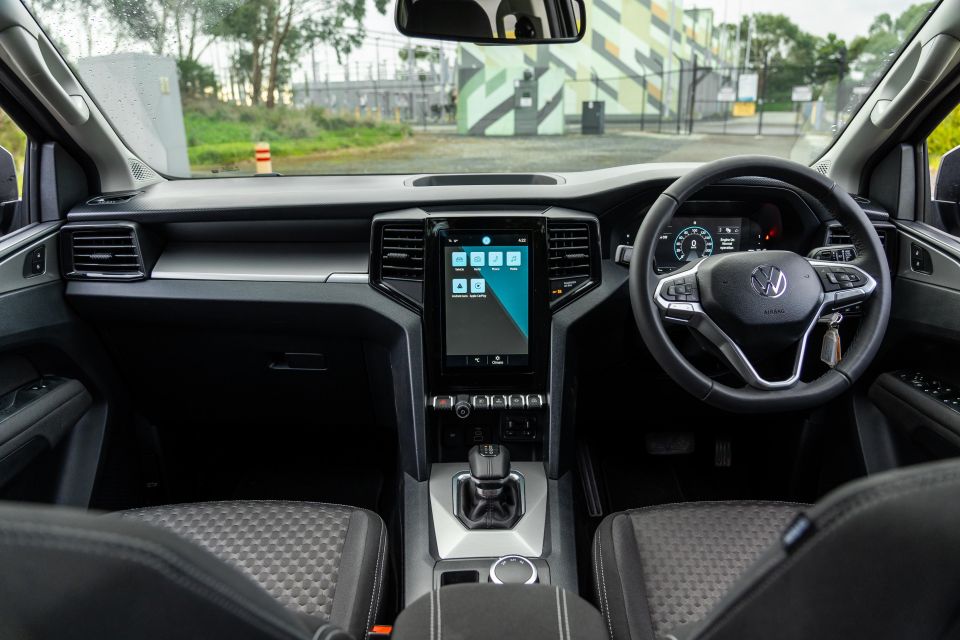
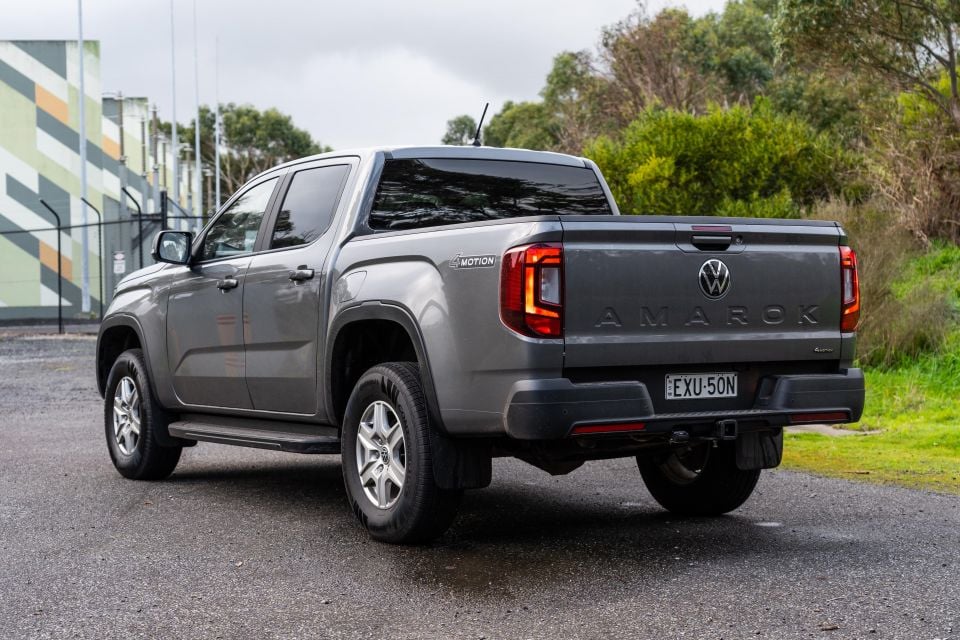
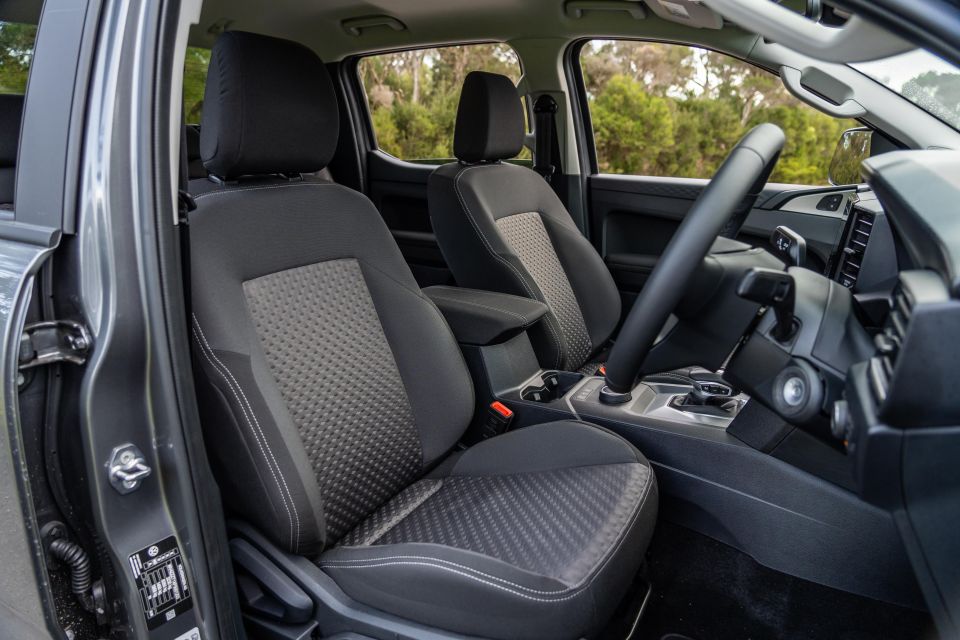
Amarok Life adds:
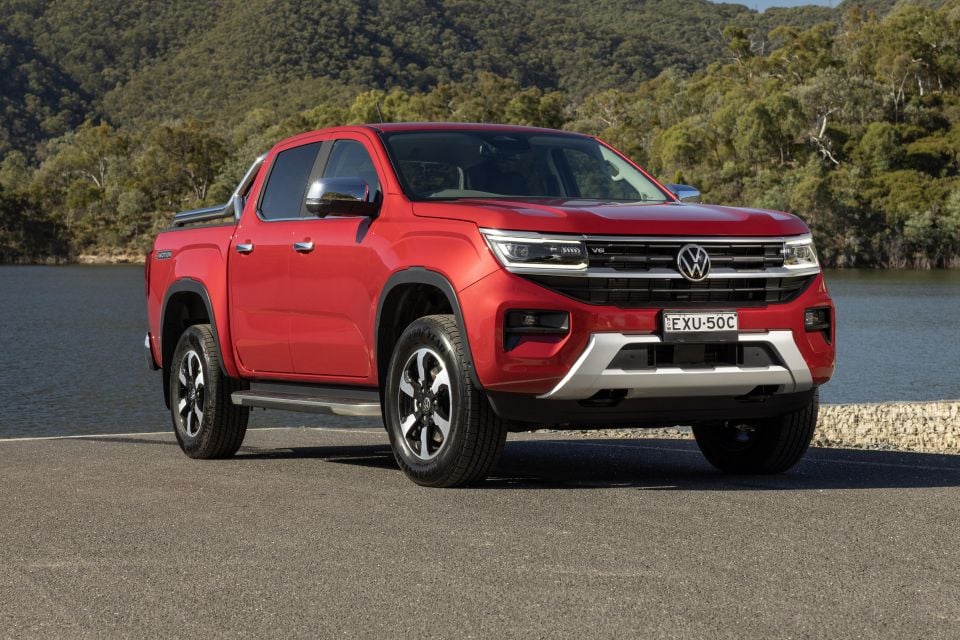
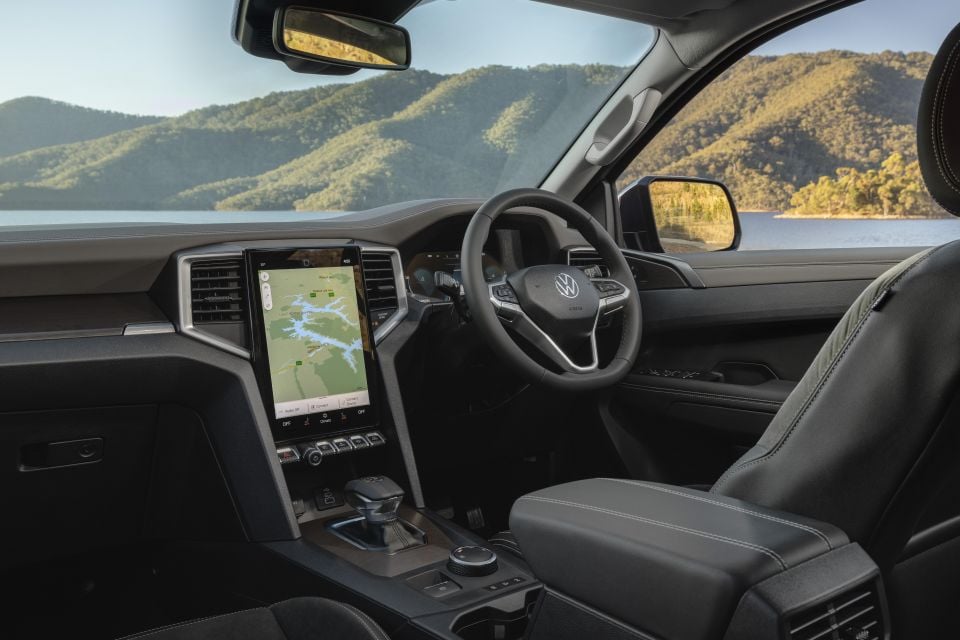
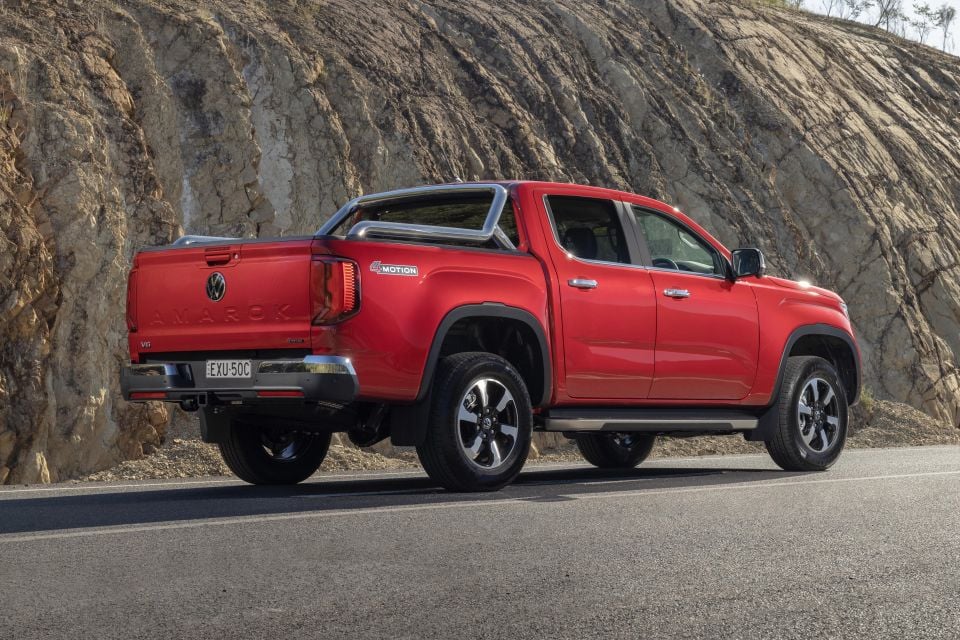
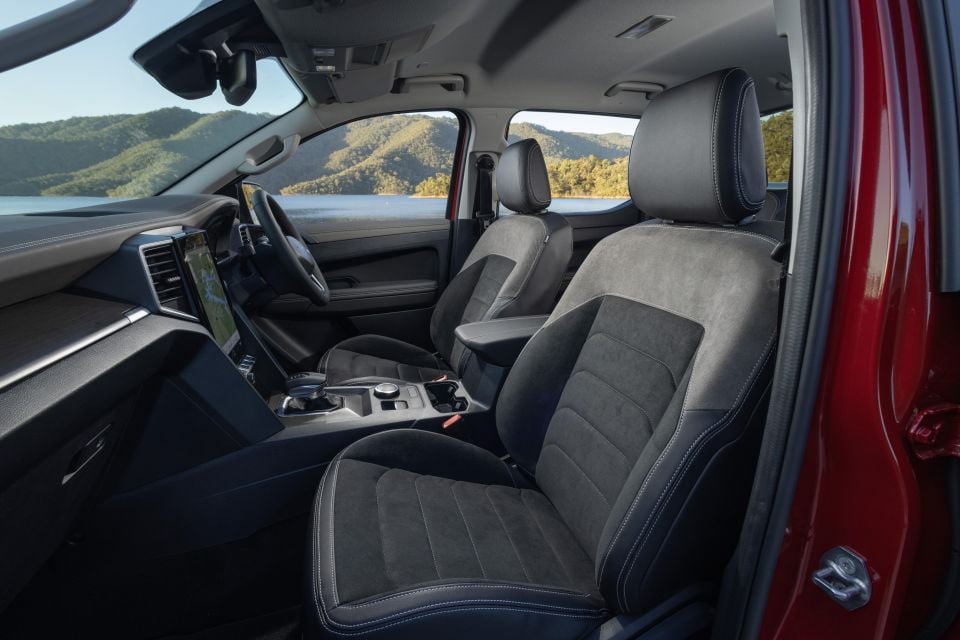
Amarok Style adds:
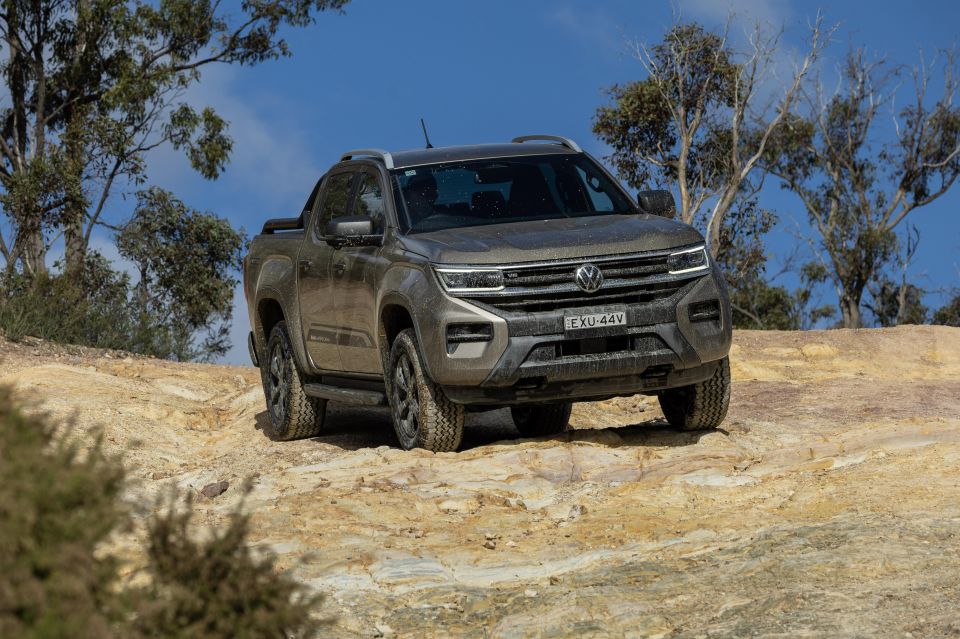

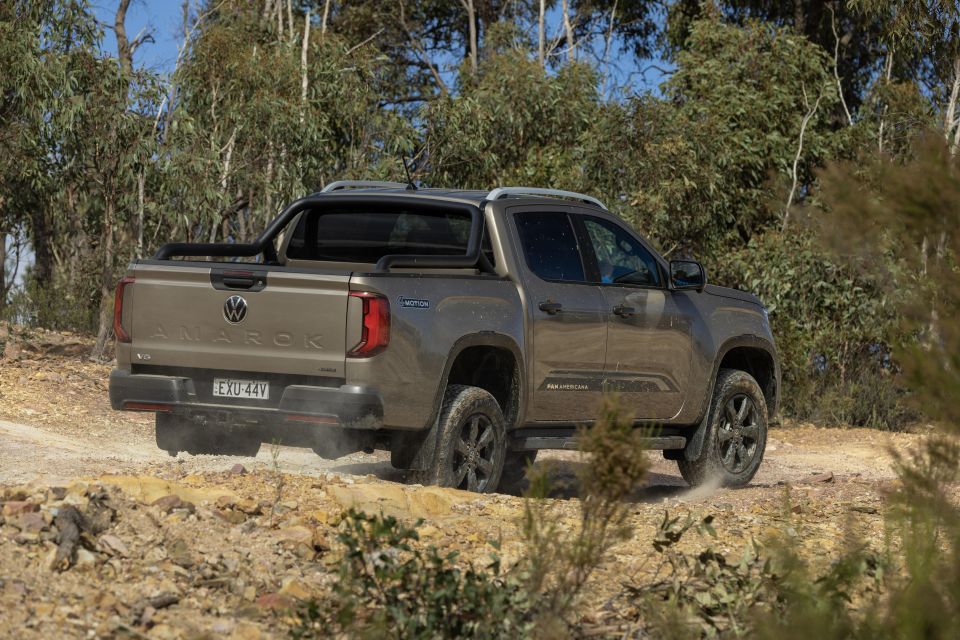

Amarok PanAmericana adds:
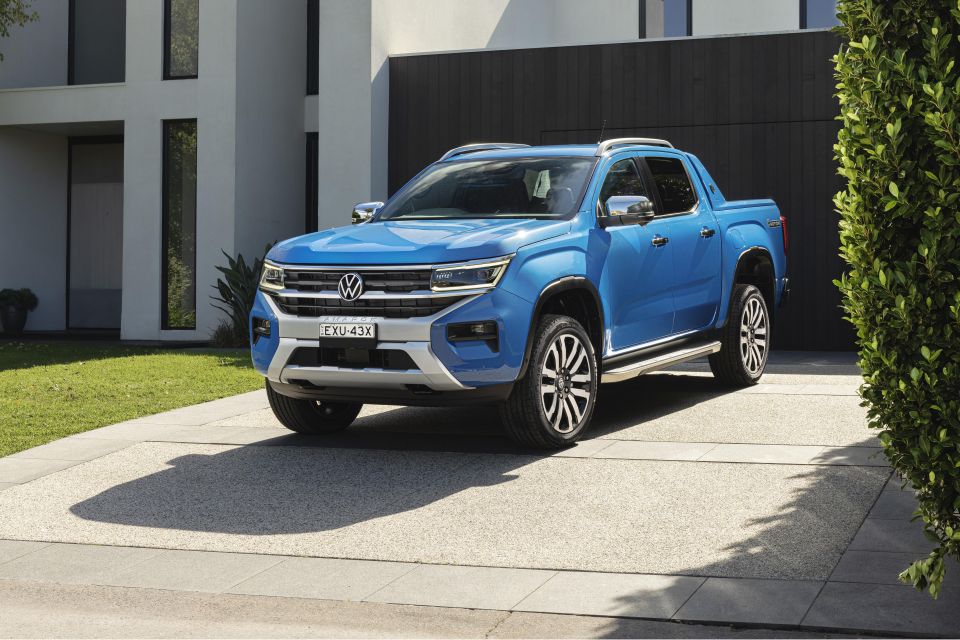
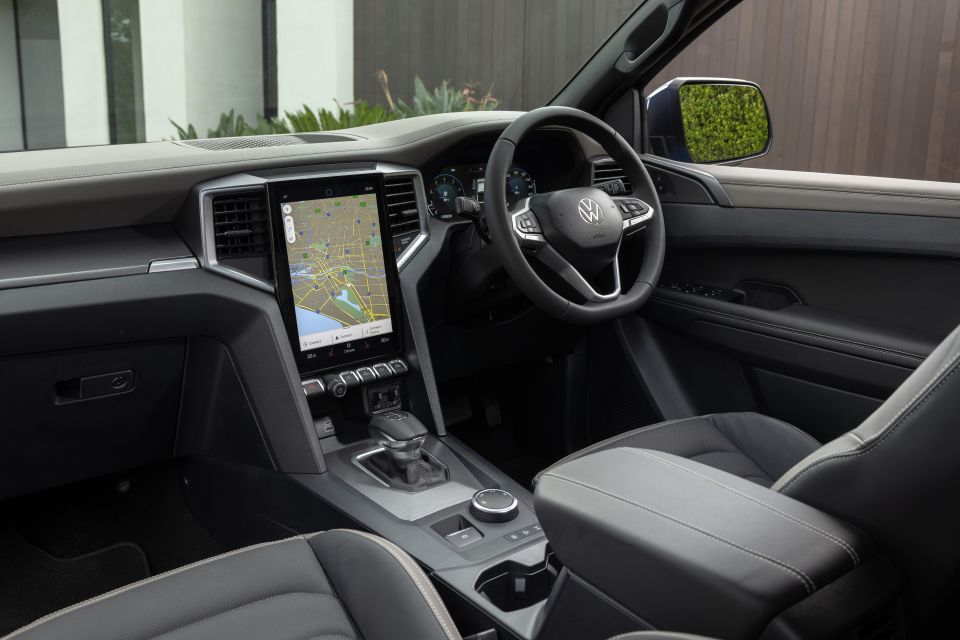


Amarok Aventura adds:
The Volkswagen Amarok was awarded a five-star ANCAP safety rating against 2020-2022 testing protocols.
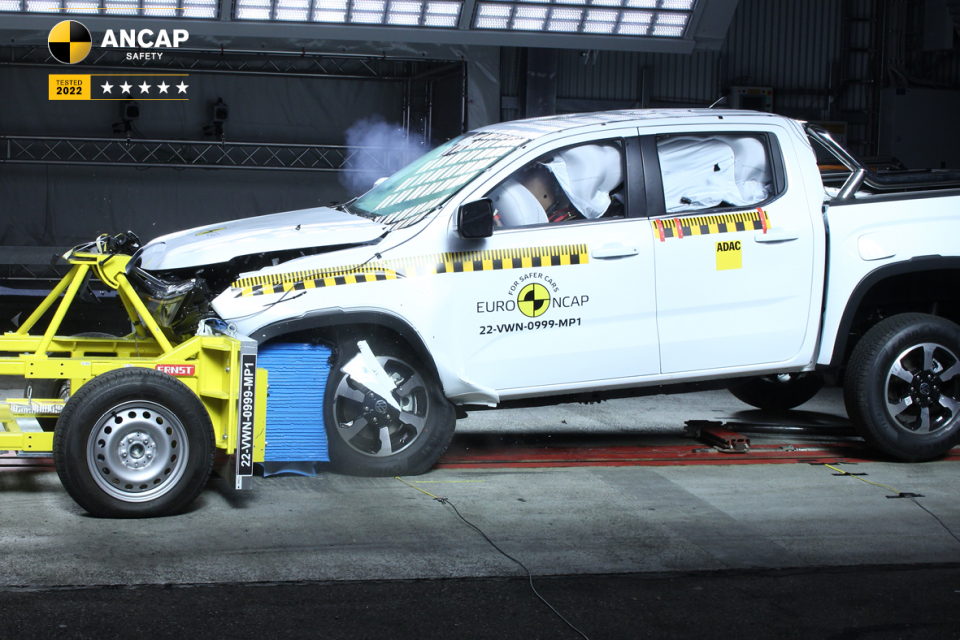
This result was drawn from testing of the closely related Ford Ranger, with additional frontal offset and side impact tests conducted on the Amarok by Euro NCAP, which has harmonised testing protocols with ANCAP.
The Amarok scored 86 per cent for adult occupant protection, 93 per cent for child occupant protection, 74 per cent for vulnerable road user protection, and 83 per cent for safety assist.
Standard safety equipment across the range includes:
Amarok Life adds:
Amarok Style adds:
Like the wider Volkswagen lineup, the Amarok is covered by a five-year, unlimited-kilometre warranty.
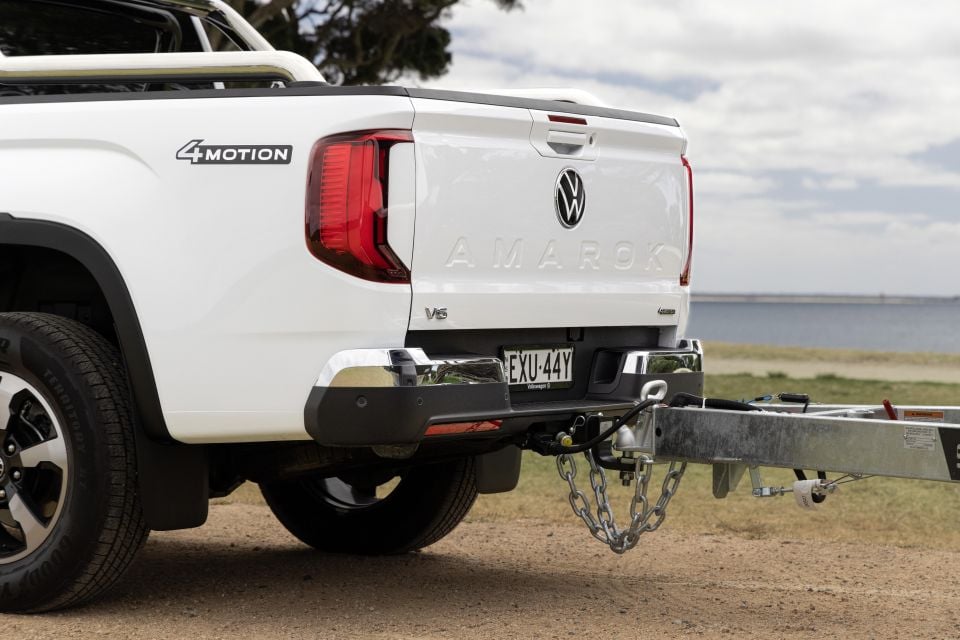
Scheduled maintenance is required every 12 months or 15,000 kilometres – whichever comes first. VW offers a five-year Care Plan across the Amarok range for $1900, $100 more than the MY23 range.
As noted earlier, select Amarok variants – i.e. Core, Life and Style – are currently being offered with a complimentary five-year Care Plan as part of an MY24 drive-away deal.
Buy your new car without the stress. It's fast, simple and completely free.

Great service from Travis and team, second time I have used this business would not hesitate to recommend them to anyone
Craig C.
Purchased a Ford Ranger in Sunshine Coast, QLD
CarExpert helped Craig save $7,224 on his Ford Ranger, now let us save you on your next new car.
Get your BEST priceThere was a lot to cover here, but it was pretty cool to experience the Amarok’s various capabilities in real-world settings.
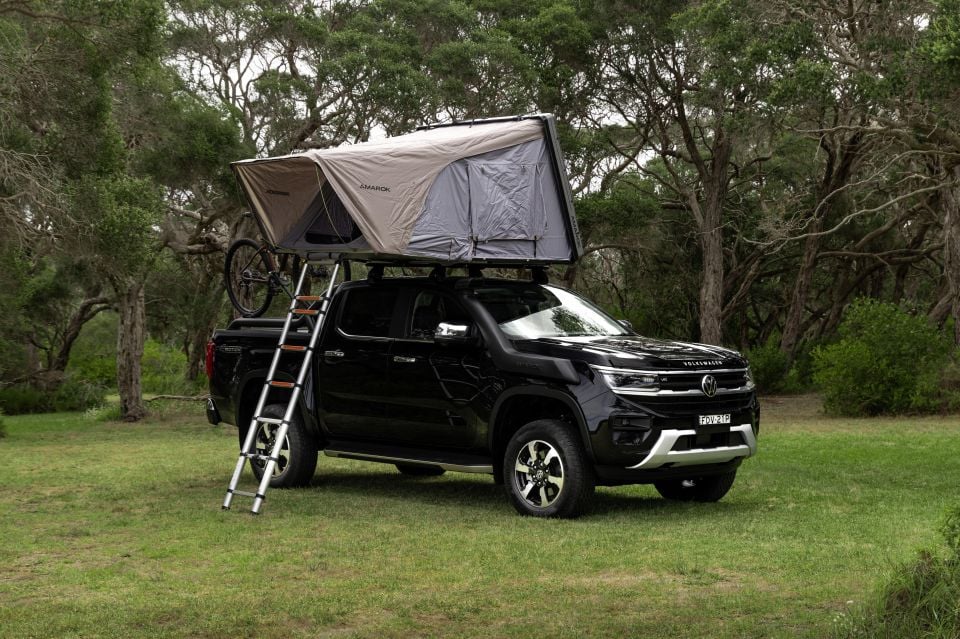
While most owners wouldn’t necessarily be going from towing a 3.0-tonne caravan straight into a rough and rutted trail climb, the breadth of ability on tap is quite impressive, as is the general level of composure and refinement the Amarok offers even in its factory standard guise.
The accessories range showcases the ability for owners to build their bespoke adventure vehicle within the Volkswagen showroom, and while genuine accessory pricing may be dearer than aftermarket solutions from third-party suppliers, it’s all guaranteed and warrantable through the same network you buy the vehicle from.
What that also means is that instead of coughing up lump sums each time you buy and install add-ons from other suppliers, you can buy or finance accessories from the dealership as part of the purchase process, too.
Like the Amarok, much of the accessories range has been designed and developed in Australia, for Australia. So, not only is it backed by VW’s warranty, but the gear should be tailored to local conditions and use cases.
Do you prefer genuine accessories through the dealer or via aftermarket suppliers? Share your thoughts in the comments below!
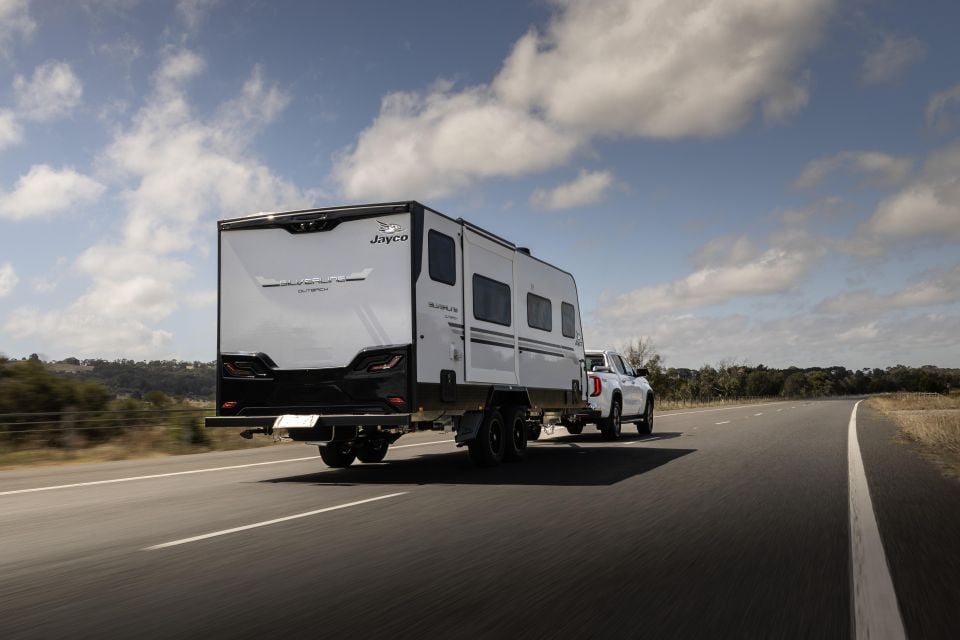
Click the images for the full gallery
MORE: Buy a Volkswagen Amarok MORE: Everything Volkswagen Amarok
Where expert car reviews meet expert car buying – CarExpert gives you trusted advice, personalised service and real savings on your next new car.
James is an automotive journalist based in Melbourne, Australia. Before joining CarExpert.com.au in 2020, James has worked at leading auto media outlets including Carsales and CarAdvice, as well as at Pulse agency for Ford Australia's communications team. In 2019 James made Mumbrella's 'Top 20 most prolific web authors in Australia' list after publishing 1,360 articles between March 1, 2018 and February 28, 2019 for CarAdvice. James is also an Ambassador for Drive Against Depression – an Australian charity whose mission is to support mental wellness through the freedom of driving and a shared love of cars.


William Stopford
1 Month Ago


Paul Maric
22 Days Ago


Max Davies
17 Days Ago


Josh Nevett
9 Days Ago
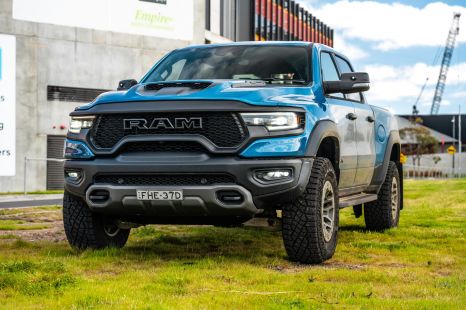

Max Davies
7 Days Ago
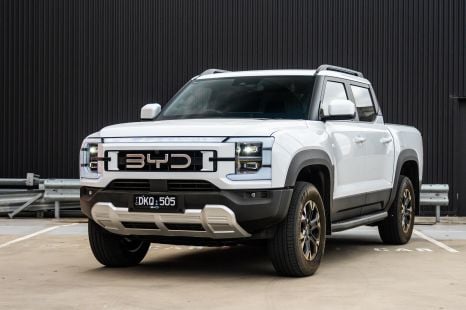

William Stopford
7 Days Ago